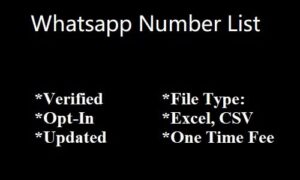WhatsApp has emerged as one of the most popular messaging apps worldwide, connecting billions of users across the globe. With its widespread adoption, questions often arise about how WhatsApp operates in terms of data usage and cellular connectivity. In this article, we will explore whether WhatsApp uses data or cellular networks for its messaging services.
Gap Heading: Data-Driven Messaging
WhatsApp primarily operates on a data-driven platform. When you send and receive messages on WhatsApp, it relies on an internet connection, which can be either through mobile data or Wi-Fi. The data-driven nature of WhatsApp allows users to exchange messages, multimedia, and other content without utilizing cellular networks, as long as they have USA WhatsApp number Data an active internet connection.
Gap Heading: Role of Cellular Networks
While WhatsApp is primarily data-driven, it does rely on cellular networks for certain functionalities. For example, when you send a message or make a call using WhatsApp while connected to mobile data, the app utilizes cellular networks to establish the initial connection. Once the connection is established, the rest of the communication happens through data transmission.
Gap Heading: Data Usage on WhatsApp
Since WhatsApp operates on an internet-based platform, it relies heavily on data usage for its various features. Sending text messages, images, videos, voice notes, and making voice or video calls all consume data. The amount of data consumed depends on the size and type of content being sent or received.
Gap Heading: Wi-Fi vs. Mobile Data
WhatsApp users have the flexibility to choose between Wi-Fi and mobile data for their internet connection. When connected to Wi-Fi, the app uses the Wi-Fi network for data transmission, helping users conserve their mobile data allocation. On the other hand, when Wi-Fi is unavailable, WhatsApp seamlessly switches to mobile data to ensure uninterrupted messaging.
Gap Heading: Data-Saving Measures
WhatsApp offers several data-saving measures to help users manage their data usage effectively. Users can enable the “Low Data Usage” option in the settings to reduce data consumption during voice and video calls. Additionally, WhatsApp provides an option to download media only when connected to Wi-Fi, saving users from unexpected data usage when Asia Email List receiving multimedia content.
Gap Heading: International Messaging
One of the significant advantages of WhatsApp’s data-driven approach is its cost-effectiveness for international messaging. Instead of incurring additional charges for sending international texts or making calls, WhatsApp leverages the internet, allowing users to communicate with contacts worldwide without extra fees.
Conclusion:
WhatsApp is primarily a data-driven messaging app that relies on an internet connection for its operations. While it does utilize cellular networks for establishing initial connections, the majority of its messaging services occur through data transmission. Users can make the most of WhatsApp’s data-driven approach by managing their data usage effectively, leveraging Wi-Fi when available, and taking advantage of data-saving features. With its seamless international communication and data-efficient nature, WhatsApp continues to be a preferred choice for millions of users around the world.



